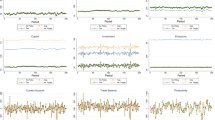Abstract
We develop an overlapping generations model of growth and the environment in which industrial firms produce environmentally harmful emissions. A government controls the emissions by assigning emission quotas to firms, and permits could be issued and freely traded as financial instruments across firms on the basis of the quotas. We show that an environmental policy that decreases an aggregate number of emission quotas could degenerate economic growth and lower environmental quality in the long run. We also show the implications of this result for environmental policy.
Similar content being viewed by others
References
Bovenberg, A. L. and B. J. Heijdra (1998), ‘Environmental Tax Policy and Intergenerational Distribution’, Journal of Public Economics 67, 1–24.
Bovenberg, A. L. and R. R. de Mooij (1997), ‘Environmental Tax Reform and Endogenous Growth’, Journal of Public Economics 63, 207–37.
Bovenberg, A. L. and S. Smulders (1995), ‘Environmental Quality and Pollution-Augmenting Technological Change in a Two-Sector Endogenous Growth Model’, Journal of Public Economics 57, 369–391.
Bovenberg, A. L. and S. Smulders (1996), ‘Transitional Impacts of Environmental Policy in an Endogenous Growth Model’, International Economic Review 37, 861–893.
Fisher, E. O’N. and C. van Marrewijk (1998), ‘Pollution and Economic Growth’, Journal of International Trade and Economic Development 7, 55–69.
Grimaud, A. (1999), ‘Pollution Permits and Sustainable Growth in a Schumpeterian Model’, Journal of Environmental Economics and Management 38, 249–266.
John, A. and R. Pecchenino (1994), ‘An Overlapping Generations Model of Growth and the Environment’, Economic Journal 104, 1393–1410.
John, A., R. Pecchenino, D. Schimmelpfennig and S. Schreft (1995), ‘Short-Lived Agents and the Long-Lived Environment’, Journal of Public Economics 58, 127–41.
Jouvet, P.-A., P. Michel and J.-P. Vidal (2000), ‘Intergenerational Altruism and the Environment’, Scandinavian Journal of Economics 102, 135–150.
Lighanrt, J. and F. van der Ploeg (1994), ‘Pollution, the Cost of Public Funds and Endogenous Growth’, Economics Letters 46, 351–361.
Marini, G. and P. Scaramozzino (1995), ‘Overlapping Generations and Environmental Control’, Journal of Environmental Economics and Management 29, 64–77.
Mohtadi, H. (1996), ‘Environment, Growth, and Optimal Policy Design’, Journal of Public Economics 63, 119–140.
Stokey, N. (1998), ‘Are There Limits to Growth?’, International Economic Review 39, 1–31.
van der Ploeg, F. and C. Withagen (1991), ‘Pollution Control and the Ramsey Problem’, Environmental and Resource Economics 1, 215–236.
Author information
Authors and Affiliations
Rights and permissions
About this article
Cite this article
Ono, T. The Effects of Emission Permits on Growth and the Environment. Environmental and Resource Economics 21, 75–87 (2002). https://doi.org/10.1023/A:1014595532338
Issue Date:
DOI: https://doi.org/10.1023/A:1014595532338




